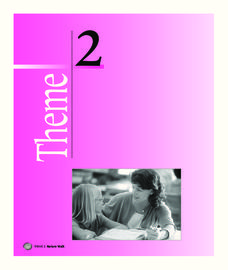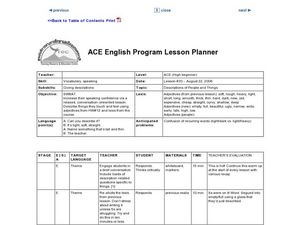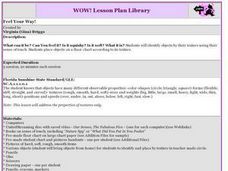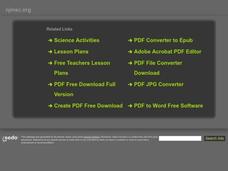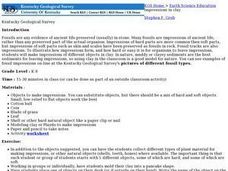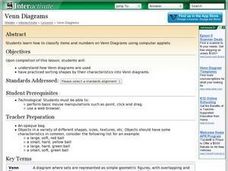Curated OER
How hard is it?
Inquiry is probably one of the most fun ways kids learn. They will test the hardness of 10 different minerals in order to classify them. They rate each of the minerals from most to least hard. Note: Having real minerals for this...
Curated OER
Sorting Objects
First graders experiment with sorting. In this sorting instructional activity, 1st graders separate objects according to one attribute: smooth, rough, hard or soft.
Curated OER
Words Ending in Soft g
Fifth graders complete a worksheet. In this sound identification lesson, 5th graders distinguish between a soft g and a hard g sound and identify words with each. Students complete a worksheet where they write and identify words with...
Curated OER
Soft Sculpture Self-portraits
Students create a soft sculpture bust of themselves using such as muslin. They color, stuff and sew the bust.
Curated OER
Easter Egg Surprise
Young readers describe objects by using describing words. After reviewing the five senses, they use their senses to gain information about an object. Then as homework, they write three descriptive words about a mystery object and place...
Houghton Mifflin Harcourt
Nature Walk: Extra Support Lessons (Theme 2)
Reinforce concepts such as long vowels, spelling patterns, sound clusters, double-final consonants, and syllables with a nature-themed unit. Through a series of extra support lessons, learners compare and contrast using a...
Curated OER
One of Our Five Senses - Touch
The wonderful world of Oobleck is entered in order to awaken your learner's sense of touch! As a warm up, learners put their hands in mystery bags in order to identify things that are wet, dry, hot, cold, hard, soft, rough, and smooth....
Curated OER
Description of People and Things
Elementary schoolers use adjectives correctly in their speech. They demonstrate adjectives using familiar objects. (For example, they might show narrow by walking between two chairs placed closely together.) Then they play antonym Bingo...
Hawaiʻi State Department of Education
Push and Pull
I love mixing arts lessons with core content! Here, the class will discuss energy, motion, and force (push/pull) as they review dance vocabulary and movements. They preview vocabulary for force and dance. Then they pair-up to dance a...
Curated OER
Texture Sculpture
Students explore a variety of everyday objects and group them according to their textures. They create a clay portrait, learning how to manipulate the material and tools to create different textures.
Curated OER
Light and Shadow
Students compare and draw items with shading based on where a light source is in relation to the object.
Curated OER
Colonial Silver and Tea
Learners examine silver pieces from colonial Boston in order to determine the social context of these objects. They compare signs of social status in colonial Boston with those of today by looking at the associated visuals.
Curated OER
To Float or Not to Float - Density
Students experiment floating a variety of objects in various liquids. They discover how density affects the ability of an object to float and apply the concept of density to solve problems.
Curated OER
Feel Your Way!
Learners investigate the sense of touch as they examine the texture of items in the classroom and from their homes. They watch a computer based video about the senses and draw items that are rough, smooth, soft, and hard.
Curated OER
F = a, Inertia, and Friction
Fourth graders use a matchbox car to push across a hard surface and observe what happens. They then push the car across a soft or rough surface and discover what happens. The two ideas are discusses as Newton's First and Second Laws of...
Curated OER
Lesson Plan Seven: Sensorama
Students identify five senses, and use their senses of touch, sight, hearing, smell, and taste to distinguish different objects, sounds, smells and tastes, and write their answers in the booklet.
Alabama Learning Exchange
Animal Classification
Present information about the classification of animals. After participating in the teacher-led discussion about scientific names, small groups devise their own way of classifying everyday objects present in the classroom, developing...
Curated OER
Sense of Touch
Students identify their five senses by reading a story. In this human anatomy lesson, students read the book, Here Are My Hands by Bill Martin Jr, and touch a variety of objects. Students describe and record each object they...
Curated OER
It Matters
Learners use descriptive vocabulary to discuss the attributes of matter. Then, they sort objects or pictures by the type of matter they are comprised of. Finally, students match objects of matter with similar attributes and create a...
Curated OER
What's in the Sock?
Second graders use their sense of touch to identify a variety of objects. In this sense of touch instructional activity, 2nd graders listen to a read aloud of Sandra Boynyon's, Fuzzy Fuzzy, Fuzzy. They talk about different textures and...
Curated OER
Classification and Identification
Students, after exploring and analyzing diagrammatic and taxonomic keys and their association to marine sciences, identify and classify objects and organisms based on visual attributes/characteristics. They research and create their own...
Curated OER
Applied Science - Science and Math Pre Lab
Students explore human senses. In this applied Science lesson, students utilize their senses to distinguish various objects. Students explain their descriptions.
Curated OER
Impressions in Clay
Students examine how fossils are created. They make impressions of different objects in clay and compare them to examples of fossils.
Curated OER
Venn Diagram and Shape Sorting Lesson Plan
Students use Venn diagrams to represent classifications of shapes and to use counting arguments to find the number of objects in a given set.





